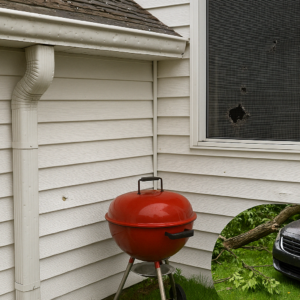How to Spot Hail Damage on Your Roof After a Storm
How to Spot Hail Damage on Your Roof After a Storm
After a powerful hailstorm, homeowners often face the critical task of inspecting their roofs for damage. Recognizing hail damage quickly can prevent further issues, save money, and simplify insurance claims. Here’s how you can effectively spot hail damage on your roof and take appropriate action.
Safety First: Before Inspecting Your Roof
Before inspecting your roof, ensure the storm has completely passed and conditions are safe. Check your surroundings carefully for downed power lines, broken branches, or unstable trees. Never attempt a roof inspection during or immediately after severe weather. If your roof is steep, high, or difficult to access safely, it’s wise to contact a roofing professional rather than inspecting it yourself.
Signs of Hail Damage From the Ground
You don’t always need to climb onto your roof to spot hail damage. From the ground, you can look for signs including:
- Dents or bends in gutters and downspouts.
- Visible damage or holes in siding, window screens, and doors.
- Damage to outdoor furniture, grills, or cars.
- Fallen tree limbs, branches, or significant debris.
If you notice any of these indicators, your roof likely sustained damage too.
Identifying Hail Damage on Shingles
Once you safely examine the roof, look closely for these specific signs:
Asphalt shingles:
- Random dents or bruises without a clear pattern.
- Loss of granules, exposing darker roofing felt.
- Circular or oval marks where hail impacts occurred.
- Cracked or broken shingles.
Metal roofs:
- Noticeable dents and punctures.
- Chipped or peeling paint indicating hail impact.
Wooden shingles:
- Visible splits, cracks, or chips.
- Bruising or discoloration indicating impact sites.
Tile roofs:
- Cracked, chipped, or broken tiles.
- Tiles knocked loose or displaced.
Other Roof Components to Check
Roofs are made up of more than shingles. Check these other critical areas:
- Gutters and Downspouts: Look for dents, cracks, and loose fittings.
- Chimney Caps and Flashing: Inspect for visible dents, cracks, or signs of separation from the roof.
- Skylights and Vents: Check for broken glass, cracked seals, and damaged metal covers.
Documenting Hail Damage
Proper documentation is essential, especially if you’re filing an insurance claim:
- Take clear photos of all damage from various angles.
- Make detailed notes, recording dates, times, and specific areas affected.
- Promptly contact your insurance provider with all collected evidence to initiate the claims process.
When to Call a Roofing Professional
It’s often wise to bring in an expert, particularly if:
- The damage appears extensive or challenging to evaluate.
- Accessing your roof safely is not feasible.
- You’re uncertain about the severity or extent of damage.
Roofing professionals will thoroughly inspect your roof and offer accurate assessments and repair recommendations.
Risks of Ignoring Hail Damage
Ignoring hail damage can result in serious long-term issues:
- Water leaks leading to interior water damage and mold.
- Structural deterioration that compromises safety.
- Increased repair costs due to delayed responses.
- Reduced home value and potential complications with insurance claims.
Repair vs. Replacement: Making the Right Choice
Several factors determine whether your roof needs repairs or complete replacement:
- Extent of Damage: Minor, localized damage might only require repairs.
- Roof Age: Older roofs with extensive hail damage may need replacement for better long-term reliability.
- Cost-effectiveness: Analyze whether repairs will sufficiently restore your roof or if replacement provides greater value and durability.
Addressing hail damage quickly after a storm is essential. Prompt action prevents further problems, simplifies the insurance process, and protects your home’s structural integrity and value.
Schedule regular professional inspections, particularly after severe storms, to ensure your roof remains in optimal condition.
Looking for a roofing contractor in Lafayette? Start here.
Need Help?
Contact Wabash Valley Exteriors today for a professional roof inspection and expert advice. Our skilled team is ready to assist you in assessing damage and providing reliable roofing solutions.


